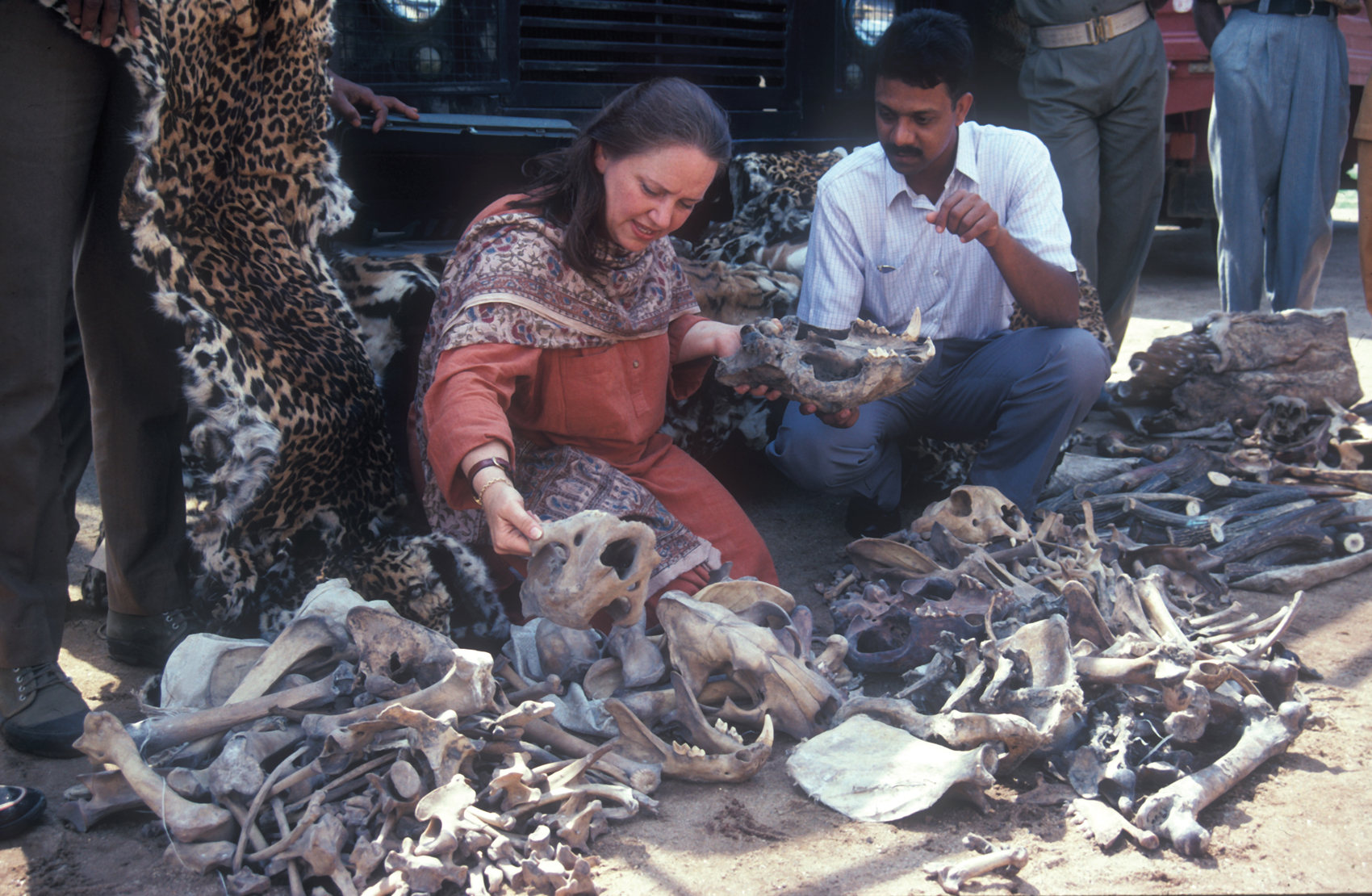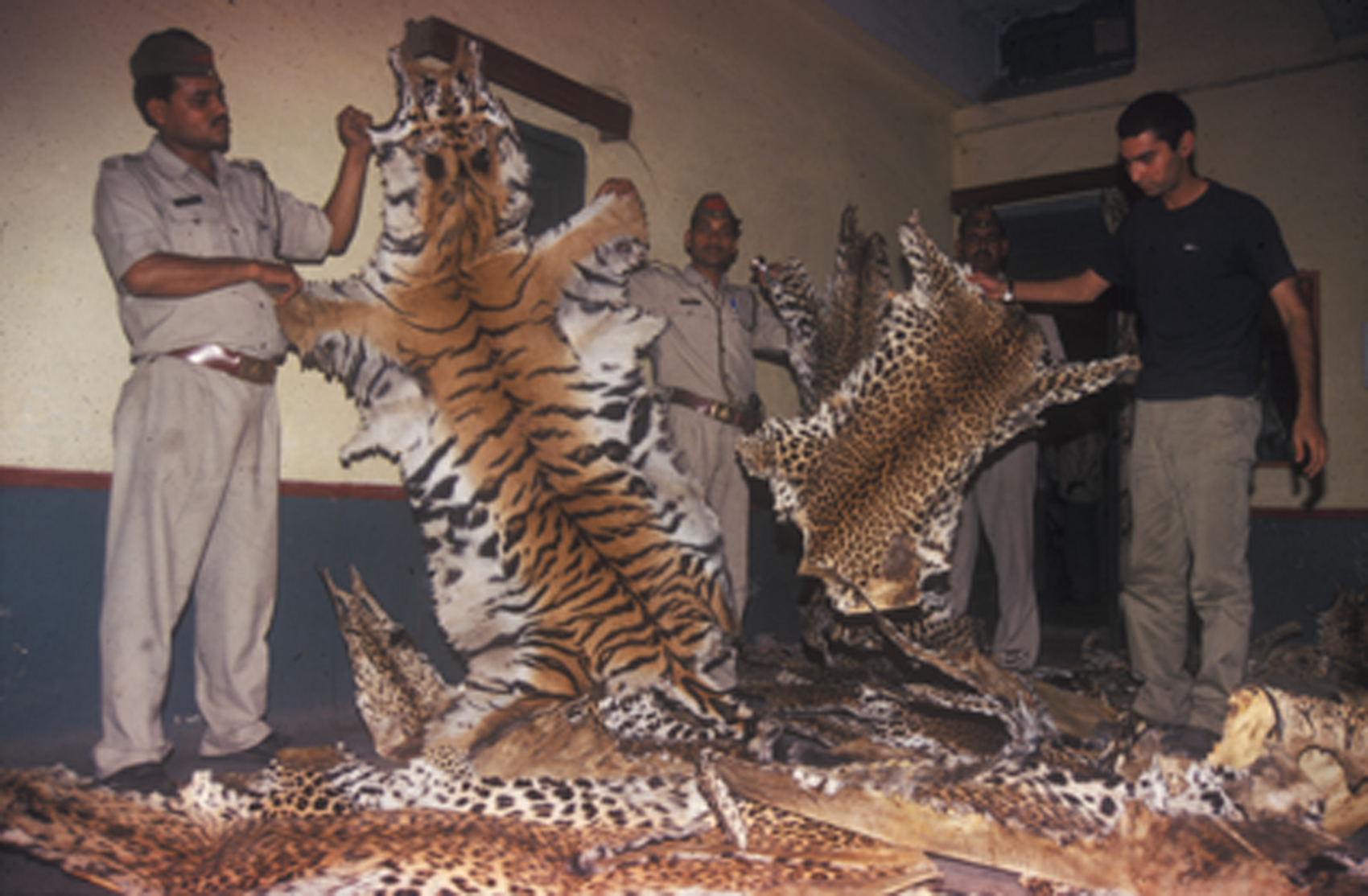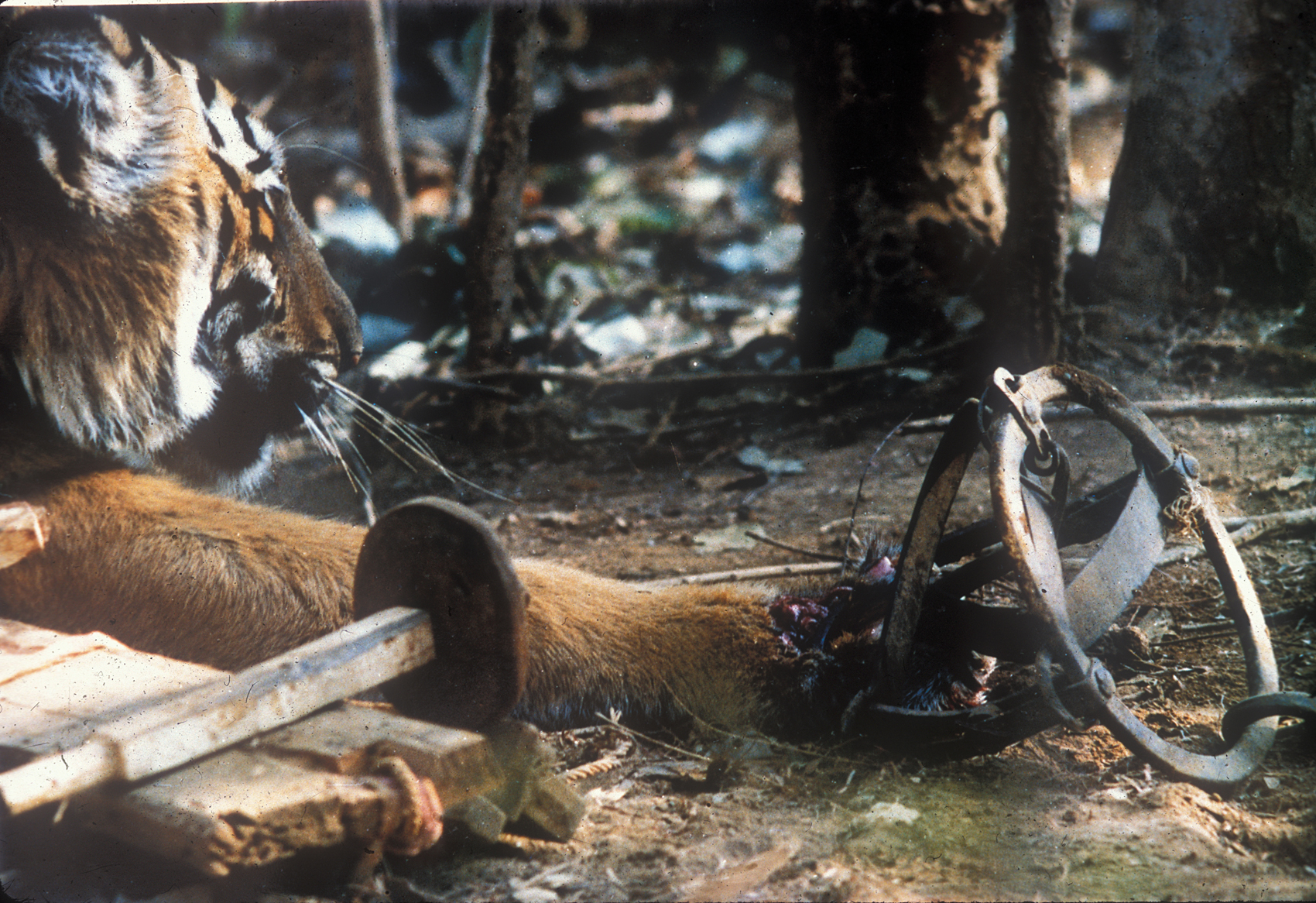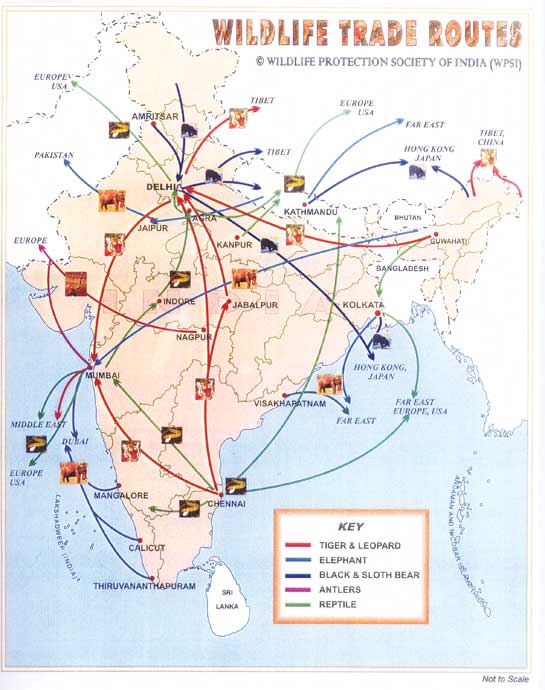Meet Belinda Wright
First published in Sanctuary Asia,
Vol. 25
No. 3,
March 2005

Belinda Wright with a haul of tiger and leopard bones that was seized by the police in 1994 at Baihar, Madhya Pradesh at the edge of the Kanha Tiger Reserve.
Courtesy: WPSI.
The One-Woman Tiger Team
She is the Executive Director of the Wildlife Protection Society of India (WPSI) and has lived in India all her life. Working with state forest and police officials for over the past decade, she has been responsible for hundreds of seizures and raids on poaching gangs. Bittu Sahgal spoke to Belinda Wright about the recent tiger crisis, exemplified by the tiger deaths in Sariska and the fact that officials were forewarned but did no act.
How come so many tigers were lifted from under our noses and we only came to know after the event?
The NGO community has been persistently highlighting the poaching of tigers and organised wildlife crime. The facts have been denied time and again by the authorities, particularly by Project Tiger and the Ministry of Environment and Forests (MoEF). It took a front page newspaper article on the absence of tigers in Sariska for the authorities to admit, albeit reluctantly, that there was indeed a serious problem. Tiger reserves are only partially open to the public (including NGOs) and we can only monitor - with some difficulty - wildlife crime outside the reserves.
How do they do this Belinda? How are they able to come in and kill tigers, when a whole nation loves the animal?
The ingenuity of tiger poachers knows no bounds. For years, tigers have been poisoned, shot and trapped. Now they are also victims of Indias widespread theft of electricity, as is shown by one of the most tragic incidents in recent times. Villagers in the Melghat Tiger Reserve in Central India laid live wires across an animal track attached to an overhead electrical line to kill deer. Instead they electrocuted a heavily pregnant tigress. When her body was found on February 3, 2003, four aborted cubs lay dead beside her.
All this is driven by money?
Yes. The oldest lure in the world. Simple villagers are used as instruments for much larger networks of highly-organised wildlife criminals who send their agents out to the remotest corners of India in search of tiger parts. Field investigators working for the Wildlife Protection Society of India (WPSI) have uncovered - particularly over the past three years - an incredible degree of sophistication among hardcore wildlife criminals. Large sums of money (in one case five lakh rupees, or about US$10,800) have been found on arrested criminals, along with mobile phones and small modern firearms.
Where does the contraband end up?
Tiger parts are destined solely for foreign countries - largely China. Skins are in demand for coat trimmings, while bones and other parts are processed in the traditional medicinal trade and then smuggled to different parts of the world. The demand has led wildlife criminals in India to collaborate closely with their counterparts in neighbouring countries like Nepal and the Tibet Autonomous Region of China. Many have been arrested in tiger-related wildlife cases in India over the past three years. Probably, the most shocking seizure in history took place on October 10, 2003 when the Chinese Customs authorities stopped a truck on the road to Lhasa - 31 tigers skins, 581 leopards and 778 otter skins were seized. Many of the skins were wrapped in Delhi newspapers. The haul represented at least one per cent of our wild tigers. Myanmar is also an important trade route. In August 2001, the Chinese police stopped a truck near the Myanmar border that was said to contain jellyfish. Instead, they found a huge haul of skins - 23 tigers, 33 leopards and 134 otters - that most likely came from India.

“Furs are worn by beautiful animals and ugly people,” suggests a world-famous campaign line. The recent disappearance of tigers from Sariska and other reserves was a direct consequence of poaching for the international trade. One tiger skin and 24 leopard skins were seized by the Special Task Force (above) in Kanpur on April 27, 2001.
Courtesy: WPSI.
Surely we know who is behind this?
Yes. The trade in tiger parts is in the hands of a few well-connected individuals, the ‘dons of the trade. There is already a huge amount of information on them, but little determination by the authorities to effectively put a stop to their activities. So the illicit trade continues.
Because of connections in high places?
In the big cases, yes - links crop up in all the big seizures. These include legal representation. They look after their own; as soon as a big seizure takes place, an aggressive and experienced lawyer is despatched to represent the accused and seek bail. This has happened with alarming swiftness in a number of cases including a huge seizure in January 2000 in Khaga, Uttar Pradesh, involving four tiger skins, 74 leopard skins, 132 tiger claws, 18,080 leopard claws and 175 tiger and other bones. With good legal representation, such a case can drag on for up to 20 years - which makes a conviction extremely unlikely.
Veerappan is dead, but another name keeps cropping up - who is Sansar Chand?
He was born in 1958, lives in New Delhi and was first convicted in April 1982, when he was sentenced to one and a half years rigorous imprisonment for a 1974 seizure that included tiger and leopard skins. After appealing his conviction, he was finally sent to jail in Delhi in 1994, but was released after six months with a paltry fine of Rs. 10,000. His father, mother, wife, son, brothers, uncle, cousins, and brother-in-law, along with various other close associates and employees, have all been accused in a number of wildlife cases throughout India. His second conviction, which was for five years rigorous imprisonment and a fine of Rs. 10,000, was in Ajmer in April 2004. He managed, however, to get bail from a superior court due to a technicality. He is now absconding from two even more recent cases in Rajasthan and Delhi.
This sounds incredible. It is like the Wildlife (Protection) Act, 1972 does not even exist.
It is just that they know how to exploit loopholes and there are also insiders who help them to do so. As of now, Sansar Chand has about 20 cases pending against him in the states of Delhi, Rajasthan, Uttaranchal, Uttar Pradesh and Andhra Pradesh. His and his wifes phone numbers appear time and again in diaries recovered from wildlife criminals.

Did Sansar Chand mastermind the Sariska tiger killings?
Courtesy: WPSI.
Where is the centre of their poaching operations, Belinda?
The two largest concentrations of professional tiger poachers and carriers are near the cities of Katni in the central Indian state of Madhya Pradesh and Samalkha in Panipat District, Haryana. WPSI has amassed a dossier on 262 known and suspected poachers of the ‘Katni gang. They are mostly based in just 13 villages in the Katni District. As many as 142 of these individuals - who have pseudonyms such as ‘Injection, ‘Capsule, ‘Cycle and ‘Senior - have been arrested in states as far afield as Karnataka, Andhra Pradesh, Maharashtra, Gujarat, Uttaranchal, and Haryana, as well as Madhya Pradesh. The steel traps they use are mainly made and distributed from Samalkha.
Two gangs? Across India? How do they move about so freely?
Not necessarily two gangs, but inter-connected communities which are a concentrated and organised supply source. They usually hire or purchase a small bus to travel long distances, with their families, to tiger and leopard habitats. Travelling cash is hidden in childrens clothing (and in one case a plaster cast). The families put up simple camps near the jungle, frequently selling cheap toys and plastic flowers as a cover. Working with local villagers, the men lay steel spring traps near tiger and leopard kills and along animal paths to catch their prey. The skins are then carried back by the ladies to Katni or Samalkha, either by train or bus. From there, they are taken by trusted couriers (who also include women) to the dons in Delhi.
How does WPSI work?
WPSI makes every effort to investigate all known tiger deaths in India. In 2001, we recorded details of 72 illegally-killed tigers. The following year, we recorded 43 tigers killed, in 2003 we recorded 35, and 2004 we recorded 33. These figures do not include the large numbers of claws and other parts that were seized or the unsubstantiated information. It is difficult to gauge the real magnitude of tiger poaching - but for the record, the Indian Customs authorities method is to multiply known offences by 10.

The tigers forests are not just home to the tiger and other wildlife but are also the reservoirs of our food and water supply. If not for the animals, then for the sake of its people, the Indian government must place wildlife protection on a much higher priority.
Photo: Belinda Wright.
Clearly all measures taken have been ineffective.
You are right, and sadly under the present system the slaughter will most likely continue because India is simply not waking up to the tiger and wildlife crisis that is overtaking it. The Forest Department is neither trained nor equipped to handle hardcore wildlife crime, and wildlife court cases (and tiger-related cases in particular) have an appalling conviction rate. In Maharashtra, for instance, it is a meagre 1.8 per cent. Political interference is also one of the biggest negative factors that prevent us from protecting our natural resources.
What has our greatest failure been?
The fact that we have been unable to effectively apprehend the city-based wildlife criminals, the masterminds and benefactors of the tiger trade, is our biggest failing in India. One positive step is the proposed Wildlife Crime Bureau, which if it is well-managed, funded and equipped could in theory investigate and act on information anywhere in India. The conservation community has lobbied vigorously for this since WPSI first proposed the idea in July 1995. Such a Bureau is essential if we are to have any hope of saving the incomparable tiger.
Do you long for the days of the late Prime Minister, Mrs. Indira Gandhi?
For her wildlife days, yes, not particularly her emergency days! Mrs. Indira Gandhi, once said: “For countless centuries, our country has been home to a magnificent array of wild creatures. Our ancestors had learned to live with them in mutual respect. We hold this great heritage in trust for future generations. Let us prove worthy of it." Mrs. Gandhi was the pillar stone of our contemporary conservation efforts. Her actions came from both her heart and her head, and she never compromised.

Snares set up to trap herbivores, all too often end up killing tigers as well.
Courtesy: WPSI.
And you see no such signs in the government today, of trying to prove “worthy of it?"
No, at least not until what is probably the most scandalous event in modern conservation history - the recent loss of all the tigers in Sariska to the hands of poachers. This is a serious wake-up call, with Sariska paying the price.
As the years go by, I wonder if we - or the world - even deserve to be the custodians of such a splendid animal as the tiger. Despite all the fanfare, the problems of protecting the tiger have increased. Our success is that we now know a lot. Our failure is that no one is acting on it. We had hoped that Indias band-aid efforts and the incredible survival instincts of Panthera tigris might have achieved the objective of keeping the crossroads static - but that was not to be. Sariska proved that. Several lesser known tiger habitats such as Panna continue to prove that.
Killer on the loose?
WPSI has been on the Sansar Chand trail for several years now, but it seems likely that the noose is slowly closing around him. As a result of the recent Sariska tiger investigations, a breakthrough may have been made. Two men were arrested in Rajasthan recently – Ballia from Jaipur and Heera Lal Khateek from Alwar. Both were interrogated by the Central Bureau of Investigation (CBI). During preliminary questioning, Khateek confessed to having sold the skin of a tiger and a panther for Rs. 49,000 and Rs. 18,000 respectively to a Delhi-based smuggler. Further investigations revealed that the poachers may have been on Sansar Chand’s payroll. Ballia claimed that he sold the raw tiger skin to Sansar Chand for Rs. 81,000. Could Sansar Chand be the mastermind behind the mass-scale killing of tigers in Sariska and Ranthambhore?
Sansar Chand belongs to a tribe of traditional wildlife traders of Western India called ‘Giharas’. After the death of Veerappan, he is considered to be India’s most dangerous wildlife smuggler, who has connections with narcotic and arms traders. He was first arrested in 1974 at the age of 18. He uses highly-paid lawyers to obtain bail and continues his nefarious trade.








